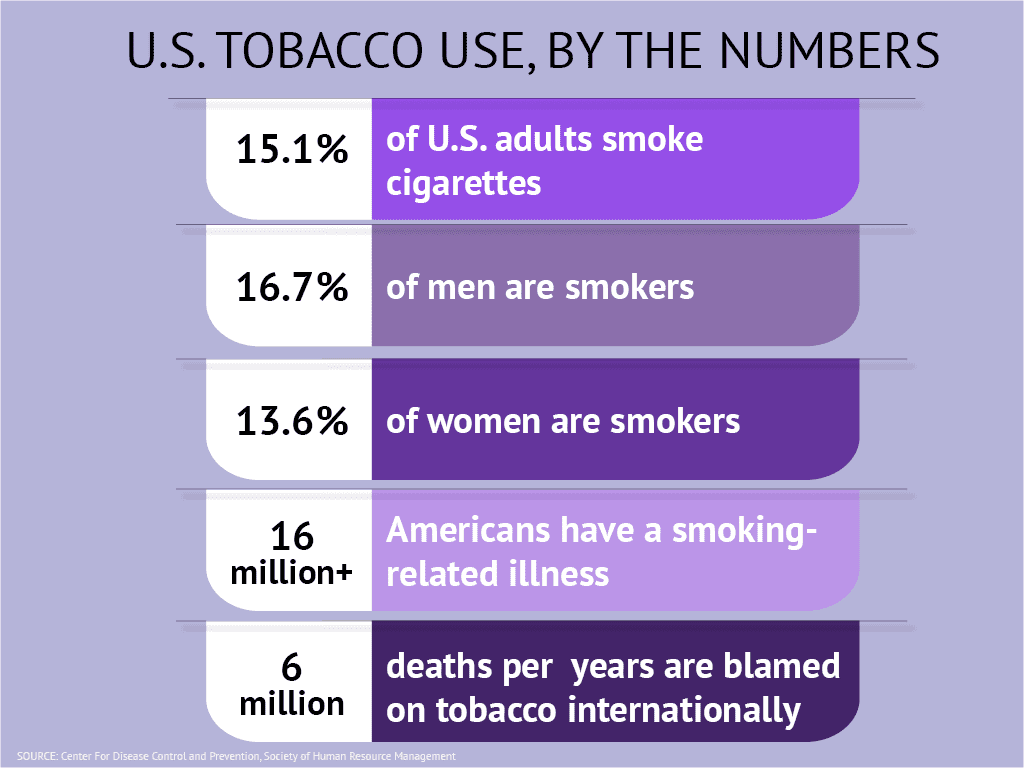Do your employees deserve extra vacation time for giving up cigarettes?
In a lot of ways, quitting smoking is its own reward. But one company has found a surprising new way to incentivize employees to put away their cigarettes. Piala, a Japanese marketing firm, gives nonsmokers six extra days of vacation since they’re not taking time during the workday for smoke breaks. That’s roughly the amount of time an average smoker will spend on smoke breaks over the course of a year.
The new policy has already had some success. Last fall, in the first few months after the rule was announced, four of Piala’s workers decided to quit smoking.
Ever wonder how much time the average American workplace spends on smoke breaks? Halo Cigs, a company that makes e-cigarette and vaping products, conducted a survey of 1,000 people employed in an array of industries.
Some industries came out a little better in the study than others. For example, the average smoker in real estate, rental and leasing goes for a smoke break for about 20 minutes on a typical workday, or 5.1 days over the course of a year.
That looks pretty good compared to the technology field, where smokers might lose an hour and 21 minutes to breaks in a typical day, or 20.5 days for the year. Those in the finance and insurance industry spend 20.2 days per year on smoke breaks.

But is it Fair?
Still, does six extra days of vacation sound a little too generous?
In Halo’s survey, only 16.4 percent of smokers and 13.6 percent of nonsmokers thought it was fair to give nonsmokers six or more extra days off work.
But many did think three to five days would be a good idea—specifically, 41.9 percent of nonsmokers and 28 percent of smokers.
The survey also asked smokers how many vacation days they would want in exchange for quitting smoking. On average, they wanted another 11 days. Smokers who work in real estate said they would ask for 13 days in exchange for giving up cigarettes.
There were some deep disagreements over whether smoke breaks themselves were fair. Only 25 percent of nonsmokers think the breaks are fair, while more than 80 percent of smokers do, Halo’s survey found.
Piala introduced its new vacation policy partly because the nonsmoker employers were frustrated by how much time the smokers were taking for breaks. As the media reported, the company operates from an office on the 29th floor, and the building’s designated smoking area is in the basement. So, a typical break might eat up about 15 minutes.
Of course, in addition to morale, there are other reasons why companies might want to encourage their team members to kick the habit.
According to the Centers for Disease Control and Prevention (CDC), smoking-related illnesses cost the United States billions of dollars each year—in the form of nearly $170 billion for direct medical care and at least $156 billion in lost productivity.

Healthier Choices
If you’re concerned about your employees’ health and want to help them quit smoking, your policies can have an impact.
In 2009, the International Agency for Research of Cancer determined that workplaces with “no smoking” rules helped reduce how many cigarettes their smoking employees consumed. And there was strong evidence those policies contributed to other workers giving up smoking entirely.
Instead of giving employees extra time off, employers can incentivize different behavior by enacting “smoking surcharges,” as the Society of Human Resource Management puts it. For example, making smokers pay more for company-sponsored health insurance. About 45 percent of surveyed HR pros said their team members had started smoking less after that rule went into effect.
Penalties aren’t the only way to get a result—you can also make a point of sharing information on why quitting is so beneficial. About 41 percent of HR professionals said their companies saw less smoking as the result of an information campaign.
That’s one thing to remember about smoking. Quitting might be difficult on an individual level, but together, we can make great progress toward greater health.
Back in 1965, more than 40 percent of American adults were smokers. Compare that to today, when approximately 15 percent of all U.S. adults smoke, according to the CDC.
Of course, that’s still 36.6 million people, so there may just be room for improvement yet.












Leave A Comment